模块1 Unit 4 Earthquakes grammar定语从句
文档属性
| 名称 | 模块1 Unit 4 Earthquakes grammar定语从句 | 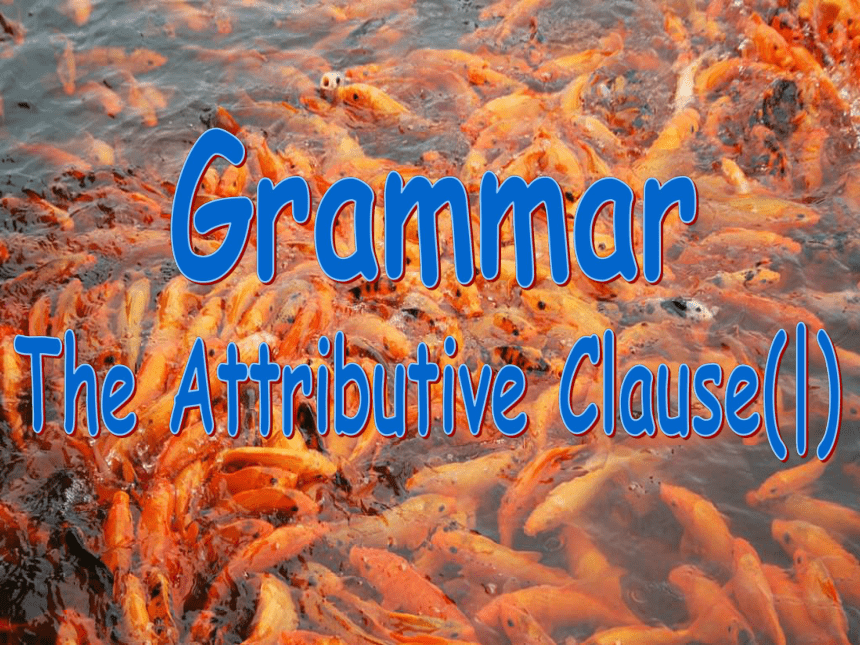 | |
| 格式 | zip | ||
| 文件大小 | 695.8KB | ||
| 资源类型 | 教案 | ||
| 版本资源 | 人教版(新课程标准) | ||
| 科目 | 英语 | ||
| 更新时间 | 2011-11-27 18:30:15 | ||
图片预览

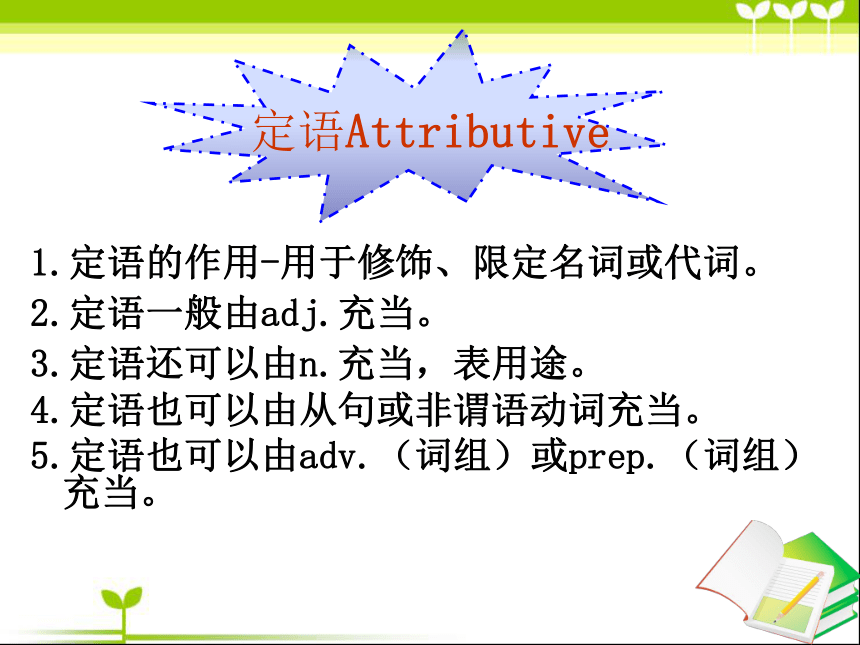
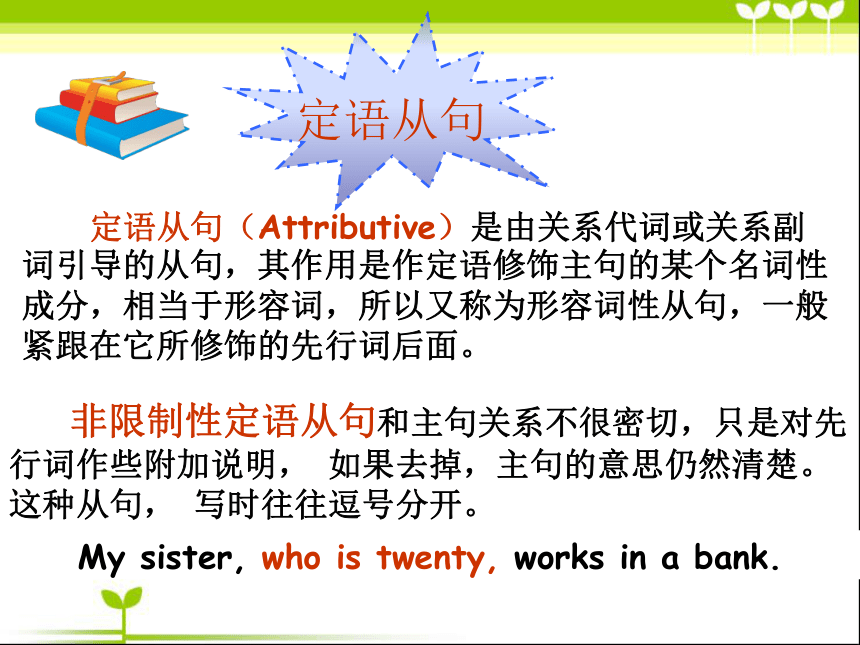
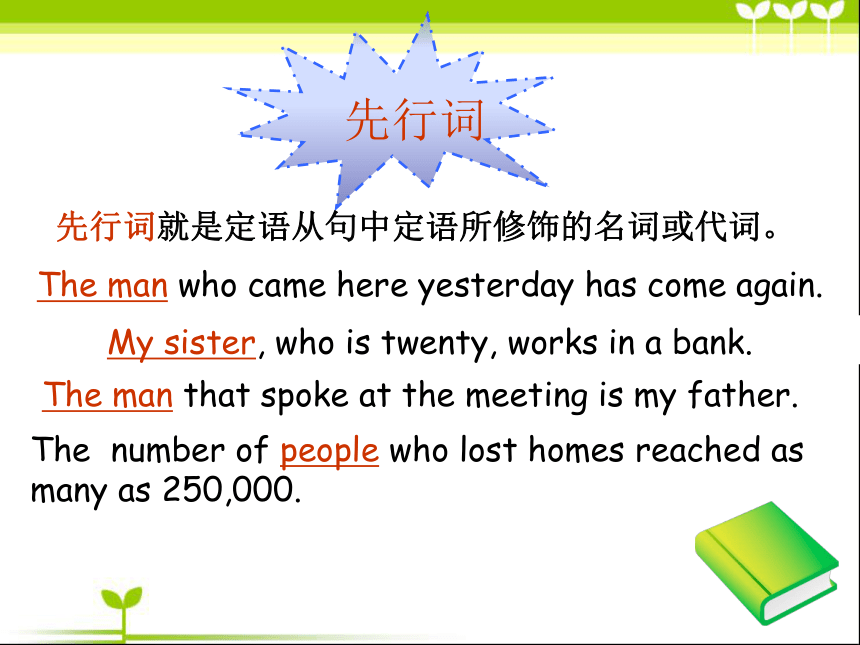

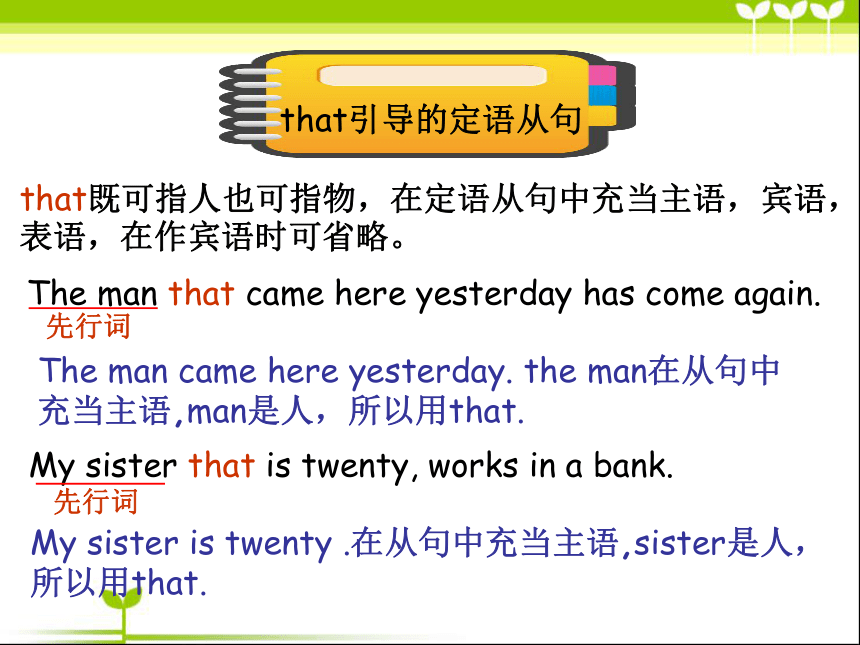
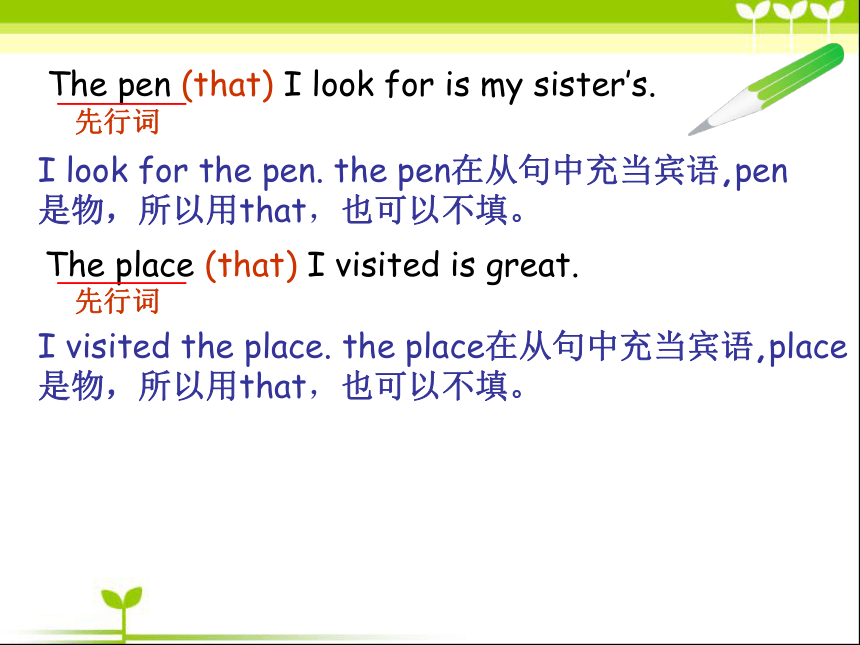
文档简介
(共16张PPT)
1.定语的作用-用于修饰、限定名词或代词。
2.定语一般由adj.充当。
3.定语还可以由n.充当,表用途。
4.定语也可以由从句或非谓语动词充当。
5.定语也可以由adv.(词组)或prep.(词组)充当。
定语Attributive
限制性定语从句是先行词在意义上不可缺少的定语,如果去掉,主句的意思就不完整或失去意义。这种从句和主句关系十分密切, 写时不用逗号分开。
The man who came here yesterday has come again.
非限制性定语从句和主句关系不很密切,只是对先
行词作些附加说明, 如果去掉,主句的意思仍然清楚。
这种从句, 写时往往逗号分开。
My sister, who is twenty, works in a bank.
定语从句
定语从句(Attributive)是由关系代词或关系副词引导的从句,其作用是作定语修饰主句的某个名词性成分,相当于形容词,所以又称为形容词性从句,一般紧跟在它所修饰的先行词后面。
先行词
先行词就是定语从句中定语所修饰的名词或代词。
My sister, who is twenty, works in a bank.
The man who came here yesterday has come again.
The man that spoke at the meeting is my father.
The number of people who lost homes reached as many as 250,000.
关系词
My sister, who is twenty, works in a bank.
The man who came here yesterday has come again.
The man that spoke at the meeting is my father.
常见的关系词:that which who whom whose
that引导的定语从句
that既可指人也可指物,在定语从句中充当主语,宾语,表语,在作宾语时可省略。
The man that came here yesterday has come again.
My sister that is twenty, works in a bank.
先行词
The man came here yesterday. the man在从句中充当主语,man是人,所以用that.
先行词
My sister is twenty .在从句中充当主语,sister是人,所以用that.
The pen (that) I look for is my sister’s.
先行词
I look for the pen. the pen在从句中充当宾语,pen是物,所以用that,也可以不填。
The place (that) I visited is great.
先行词
I visited the place. the place在从句中充当宾语,place是物,所以用that,也可以不填。
which引导的定语从句
which指物,事情,在定语从句中充当主语,宾语,表语,在作宾语时可省略。
The book (which) I look for is my sister’s.
先行词
I look for the book. the book在从句中充当宾语,book是物,所以用which/that,也可以不填。
The school which looks great.
先行词
The school is great. the school在从句中充当主语,school是物,所以用which/that。
who引导的定语从句
who指人,在定语从句中充当主语,宾语,表语。在作宾语时可省略。
I know about the man who spoke to you just now.
先行词
The man spoke to you just now. the man在从句中充当主语,man是人,所以用who/that。
The man (who) we invited to the party is Mike.
先行词
We invited the man to the party. the man在从句中充当宾语,man是人,所以用who/that,或者不填。
whom引导的定语从句
whom指人,在定语从句中充当宾语,常可省略。
The man whom you saw is my English teacher.
先行词
You saw the man is my English teacher. the man在从句中充当宾语,man是人,所以用who/that/whom。
Here is the man whom you are looking for.
先行词
You are looking for the man . the man在从句中充当宾语,man是人,所以用who//whom。
whose引导的定语从句
Whose可修饰人也可修饰物,在从句中充当定语。
This is the scientist whose name is known all the world.
先行词
The scientist’s name is known all the world. the scientist在从句中充当定语,scientist是人,所以用whose。
1.This is the boy________________ I shall look after tomorrow.
2.The boy to __________ you talked just now is a good football player.
3. My family climbed up the hills on the top of ________ we had a picnic before.
4. He still lives in the room ________ window faces to the east.
exercise
(who/whom/that )
whom
which
whose
1. 先行词为all, little, much, everything, nothing, something, anything等不定代词
2.先行词被all, little, much, every, no, 等修饰时。
3.先行词被序数词或最高级修饰先行词前有序数词(the first),形容词最高级(the best), the last, the very, the only 等时。
4.先行词为人和物的组合.
只用that,不用which的情况:
5.若主句中有疑问代词 who 或者 which,为了避免重复, 关系代词不要再用which,而用 that。
1,逗号后面 2,介词后面
只用which ,不用 that的情况:
只用who
1.先行词one, ones, anyone, all, those指人时引导词用who。
2.在there be 句型中,先行词指人时。
3.从句中有两个定语从句且都指人时,引导词一个用who 一个用that。
1. The famous basketball star, ____ tried to make a comeback, attracted a lot of attention.
A. where B. when C. which D. who
2.Women ___drink more than two cups of coffee a day have a greater chance of having heart disease than those ___ don't.
A. who;/ B. /; who C. who; who D. /;/
3.Look out! Don't get too close to the house ___ roof is under repair.
A. whose B. which C. of which D. that
1.定语的作用-用于修饰、限定名词或代词。
2.定语一般由adj.充当。
3.定语还可以由n.充当,表用途。
4.定语也可以由从句或非谓语动词充当。
5.定语也可以由adv.(词组)或prep.(词组)充当。
定语Attributive
限制性定语从句是先行词在意义上不可缺少的定语,如果去掉,主句的意思就不完整或失去意义。这种从句和主句关系十分密切, 写时不用逗号分开。
The man who came here yesterday has come again.
非限制性定语从句和主句关系不很密切,只是对先
行词作些附加说明, 如果去掉,主句的意思仍然清楚。
这种从句, 写时往往逗号分开。
My sister, who is twenty, works in a bank.
定语从句
定语从句(Attributive)是由关系代词或关系副词引导的从句,其作用是作定语修饰主句的某个名词性成分,相当于形容词,所以又称为形容词性从句,一般紧跟在它所修饰的先行词后面。
先行词
先行词就是定语从句中定语所修饰的名词或代词。
My sister, who is twenty, works in a bank.
The man who came here yesterday has come again.
The man that spoke at the meeting is my father.
The number of people who lost homes reached as many as 250,000.
关系词
My sister, who is twenty, works in a bank.
The man who came here yesterday has come again.
The man that spoke at the meeting is my father.
常见的关系词:that which who whom whose
that引导的定语从句
that既可指人也可指物,在定语从句中充当主语,宾语,表语,在作宾语时可省略。
The man that came here yesterday has come again.
My sister that is twenty, works in a bank.
先行词
The man came here yesterday. the man在从句中充当主语,man是人,所以用that.
先行词
My sister is twenty .在从句中充当主语,sister是人,所以用that.
The pen (that) I look for is my sister’s.
先行词
I look for the pen. the pen在从句中充当宾语,pen是物,所以用that,也可以不填。
The place (that) I visited is great.
先行词
I visited the place. the place在从句中充当宾语,place是物,所以用that,也可以不填。
which引导的定语从句
which指物,事情,在定语从句中充当主语,宾语,表语,在作宾语时可省略。
The book (which) I look for is my sister’s.
先行词
I look for the book. the book在从句中充当宾语,book是物,所以用which/that,也可以不填。
The school which looks great.
先行词
The school is great. the school在从句中充当主语,school是物,所以用which/that。
who引导的定语从句
who指人,在定语从句中充当主语,宾语,表语。在作宾语时可省略。
I know about the man who spoke to you just now.
先行词
The man spoke to you just now. the man在从句中充当主语,man是人,所以用who/that。
The man (who) we invited to the party is Mike.
先行词
We invited the man to the party. the man在从句中充当宾语,man是人,所以用who/that,或者不填。
whom引导的定语从句
whom指人,在定语从句中充当宾语,常可省略。
The man whom you saw is my English teacher.
先行词
You saw the man is my English teacher. the man在从句中充当宾语,man是人,所以用who/that/whom。
Here is the man whom you are looking for.
先行词
You are looking for the man . the man在从句中充当宾语,man是人,所以用who//whom。
whose引导的定语从句
Whose可修饰人也可修饰物,在从句中充当定语。
This is the scientist whose name is known all the world.
先行词
The scientist’s name is known all the world. the scientist在从句中充当定语,scientist是人,所以用whose。
1.This is the boy________________ I shall look after tomorrow.
2.The boy to __________ you talked just now is a good football player.
3. My family climbed up the hills on the top of ________ we had a picnic before.
4. He still lives in the room ________ window faces to the east.
exercise
(who/whom/that )
whom
which
whose
1. 先行词为all, little, much, everything, nothing, something, anything等不定代词
2.先行词被all, little, much, every, no, 等修饰时。
3.先行词被序数词或最高级修饰先行词前有序数词(the first),形容词最高级(the best), the last, the very, the only 等时。
4.先行词为人和物的组合.
只用that,不用which的情况:
5.若主句中有疑问代词 who 或者 which,为了避免重复, 关系代词不要再用which,而用 that。
1,逗号后面 2,介词后面
只用which ,不用 that的情况:
只用who
1.先行词one, ones, anyone, all, those指人时引导词用who。
2.在there be 句型中,先行词指人时。
3.从句中有两个定语从句且都指人时,引导词一个用who 一个用that。
1. The famous basketball star, ____ tried to make a comeback, attracted a lot of attention.
A. where B. when C. which D. who
2.Women ___drink more than two cups of coffee a day have a greater chance of having heart disease than those ___ don't.
A. who;/ B. /; who C. who; who D. /;/
3.Look out! Don't get too close to the house ___ roof is under repair.
A. whose B. which C. of which D. that
